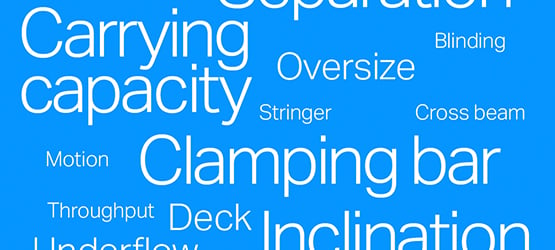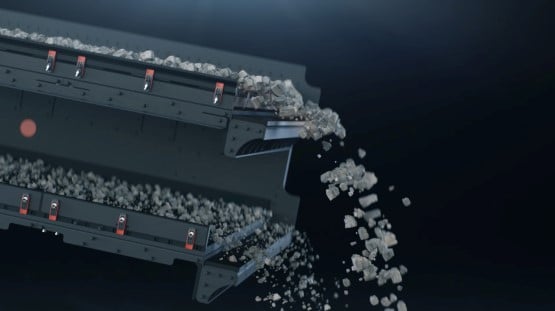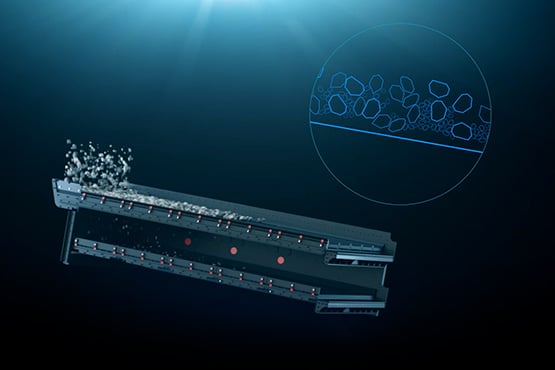Screening terminology

Throughout the Knowledge Hub we’ve been exploring mechanical screening and explaining its terminology as it arises. To keep on top of things, now is a good time to sum up these terms and provide a place where you can find definitions for the technical language involved in screening.
This glossary should help you grasp the terminology used throughout the Knowledge Hub and help you understand more about the principles of mechanical screening.
Bed depth
The thickness of the material on a screen deck during operation.
Blinding
This occurs when screening is restricted by material stuck to the screen surface, typically caused by moisture.
Carrying capacity
The maximum amount of material that can be inside the screen at any given time without impacting on screening performance.
Central hold-down bar
A bar running the length of the screen that keeps the screening material firmly in place. If a central hold-down bar is used, the deck will have a double-crown, with the bar running along the valley between the two crowns.
Clamping bar (or Side rail)
These are fastened onto the inside of the side plates to hold the screening media firmly in place and maintain the correct tension.
Closed circuit and open circuit
These terms refer to crushing and screening operations. In a closed circuit, oversize material from the screen is fed into a crusher then conveyed back into that screen. This process repeats until all oversize material is crushed and has passed through the screen as throughput. In an open circuit, screened material may move on to further processing but does not re-enter the same screen.
Cross member (or Cross beam)
A bar that connects the side plates and strengthens the screen. These are typically made of steel as the vibrations of the screen can put them under significant strain.
Crown (or Camber)
Screens designed for tensioned media have the support bars positioned so that the screening media forms a curve, with the center higher than the sides. This convex shape is known as a crown or camber. When the clamping bars along the side plates are tensioned the screening media is held firmly against the support bars.
Dam bars
These sit across the decks and slow the flow of material. This can be especially useful when there is too little material on the deck (ie. when there is a low material bed). They increase the time it takes for the material to pass over the deck, reduce bouncing, increase probability, and reduce undersize in overflow. In wet screening they can help ensure that material is washed adequately.
Discharge lip
An angled piece of metal that sits at the end of the screen, to direct the overflow (typically into chutes) as it exits.
Deck
To be precise, the deck is the frame which holds the screening media in place. However, it’s often used to mean the entire surface that blocks larger particles and allows smaller particles to fall through. There can be several decks inside the screening machine.
Feed box
This sits at the feed end of the screen, receiving the material from the conveyor or chute and evenly distributing it into the screen.
Feed curve / Product curve
The relative size distribution of particles in the material that is fed to / discharged from the screen.
G-force
The force of acceleration acting on a screen.
Inclination
The gradient or angle of the deck to the horizontal.
Motion
In screening, motion refers to the screen being vibrated to encourage stratification and separation (such as circular, linear or elliptical motion).
Multi-slope (or banana)
This describes screens where the gradient changes as the the material passes through the screen (almost always from a steeper to a shallower gradient). An alternative to a one-slope screen. Multi-slope screens can often provide increased capacity and efficiency, especially for fines.
Overflow
Material that passes over the decks in a screen and exits at the discharge end (see image below).

Oversize in underflow
Material in the underflow with a particle size greater than the separation size.
Particle shape
The geometry of the particles that are being screened (round or cubical, for example).
Pegging
This occurs when screening is restricted by stones getting wedged in the holes on the screen media.
Screening
The mechanical process of separating particles according to size.
Separation
The process of using a screen (a surface with holes or apertures) to remove particles of less than a certain size from a mass of mixed particles.
Side plate
The vertical plates that make up the body of the screen, standing on either side of the screen and connected by the decks.
Spray bars
Wet screening can often increase screen capacity, but it is expensive and water is a limited resource in many locations, so it is only used when necessary. Spray bars have polyurethane nozzles that distribute water onto the material bed.
Stratification
The process by which fine particles in a mass moves to the bottom of the material bed, prompted by a combination of gravity and vibration (see image below).

Stringer (or Support bar, Bucker bar)
These are flat bars or profiles that that sit underneath the screening media, to support it and hold it in place. They are typically made from steel.
Stroke
The distance which the screen moves during its operation (that is, the extent of its displacement when in motion).
Throughput
Material that passes through all the decks in a screen.
Throughput capacity
The amount of material that can pass through a screen of a stated area for a stated time (typically measured in tons per hour per m2).
Underflow
Material that passes through a deck in a screen.
Undersize in overflow
Material in the overflow with a particle size less than the separation on the deck, which should have passed through the screen deck.